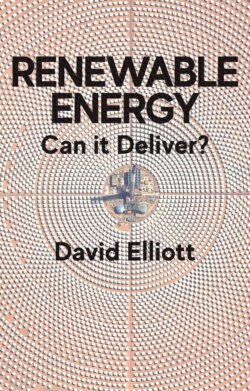Читать книгу Renewable Energy - David Elliott - Страница 12
Box 1.2 The new energy options – a summary of impacts and issues
ОглавлениеThe use of naturally and continuously replenished renewable energy flows, like the winds, waves, tides and solar heat/light, produces no direct carbon dioxide (CO2) or other emissions. There will be indirect emissions due to the use of fossil fuel for the construction of the technologies and for the production of associated materials, but that is true, at present, for all energy technologies. Once built, renewable energy-based power plants, like wind turbines and solar farms, differ from the rest in not needing any fuel to run. However, they may have some local impacts, and some (but not all) produce variable power outputs.
Those issues apart, they are strong ‘clean energy’ contenders, arguably more so than nuclear plants, which, although they do not produce CO2 in operation, rely on the use of fossil fuel to mine and process/enrich their fuel, a very energy-intensive process, thus incurring a carbon debt. There are also long-lived radioactive wastes to deal with, as well as the risk of leaks and unplanned release of radioactive material. Global fissile fuel reserves are also finite; they are not a renewed resource. Nuclear fusion, as opposed to fission, is still some way off as a practical option and may remain so but might have fewer fuel resource limitations, although there could still be risks and radiological implications.
It is possible to capture and store the CO2 produced by fossil fuel combustion plants, but, although that might allow us to continue to use fossil fuel, as I will be describing, there are operational and economic limitations to this arguably rather inelegant ‘end of pipe’ engineering approach to post-combustion ‘carbon capture and storage’. The environmental argument is that we should not be burning fossil fuel in the first place nor trying to find places to store the resultant CO2 safely and indefinitely. The global fossil fuel resource is in any case finite, so using it is not a long-term option, even ignoring CO2 and other emissions and impacts, for example in relation to air quality.
The combustion of biomass (plants, wood and other bio-materials), and then the capture and storage of the CO2 produced, is an option. In theory, since CO2 is absorbed when biomass is grown, that process would be carbon negative, reducing net atmospheric CO2 levels. However, to have a significant CO2 impact, in addition to vast CO2 storage requirements, very large amounts of biomass would have to be grown and burnt, with large land-use and ecological impacts.
The capture and storage of CO2 direct from the air is also possible, although that process would use energy rather than generate it. As an alternative, some of this CO2, or the CO2 from power plants, might be used to make new hydrocarbon fuels, if a source of hydrogen were available, for example produced using renewable energy. However, burning the resultant synthetic hydrocarbon fuels would release the CO2 again. It might be better to use the ‘green’ hydrogen direct as a fuel since its combustion only produces water vapour.
I will be coming back to these various options, issues and choices later, for example looking at costs, but from this short summary it does look as though, in terms of clean energy supply, renewables have the edge environmentally.
